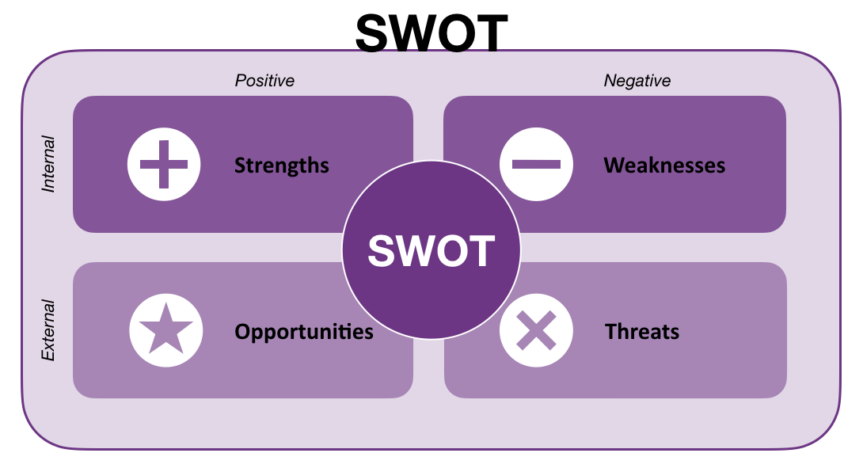Using SWOT analysis to support your business
What is SWOT analysis and how can it help your business? myLIFE gives you the keys to understanding how it works and explains how to implement it in order to improve your company’s strategy.
Two years ago, Thomas opened a small artisan bakery in the heart of a lively part of his town. Helped by his wife, the thirty-year-old passionate baker hopes to introduce his gourmet specialties to locals. But for the moment, success is slow to come and, despite firmly believing in the quality of his products and his location, Thomas doesn’t really understand why. His friend Nelson, who works in marketing, advises him to carry out a SWOT analysis to identify areas where improvement could still be made. What exactly is SWOT analysis and how should he approach it?
What is SWOT analysis?
SWOT analysis or SWOT matrix is a tool used to pinpoint a company’s options for growth by evaluating its internal and external data. SWOT stands for Strengths, Weaknesses, Opportunities and Threats. It involves identifying a company’s strengths and weaknesses, but also its development opportunities and the external threats it may face.
By carrying out an analysis of this type, Thomas would obtain an overview of his business and be able to position the bakery against the competition. This would allow him to better identify and leverage the company’s assets, but also to spot any areas for improvement, while taking into account market opportunities and threats. The analysis would not be a miracle cure for his problem, but its results would help him when it comes to decision-making and optimising his strategy by identifying concrete action that could be taken.
SWOT analysis is an effective tool for young entrepreneurs looking to progress, but it can also be used when creating a company for the launch of a new product, a website or for any other professional or personal project.
SWOT analysis consists of completing a table with four sections (strengths, weaknesses, opportunities and threats), by answering a series of questions.
How to do a SWOT analysis
The first step is to identify objectives. This may seem silly, but before any analysis we need to determine the purpose for which it is being carried out: to offer a new service, attract more clients, improve competitive edge, target a different market, etc. Based on this, relevant information can be gathered as food for thought (company figures, market research, client surveys, etc.).
Next, the entire company ecosystem will be reviewed: its internal resources (products and services, financial means, distribution system, human resources, skills, equipment, location, etc.) and external resources (competition, suppliers, economic and cultural environment, political situation, legislation, etc.).
SWOT analysis consists of completing a table with four sections (strengths, weaknesses, opportunities and threats), by answering a series of questions.

What are the key issues to consider?
> Strengths: what are the company’s strengths? What are its competitive advantages? What do clients appreciate the most? For example: specific expertise, a rare product, a strategic location, a well-known brand name, a loyal client base, etc.
> Weaknesses: what are the company’s limitations and weaknesses? What do clients dislike? What areas could be improved on? For example: obsolete equipment, inadequate product diversification, poor geographic location, lack of company communication, lack of team training, etc.
> Opportunities: what untapped opportunities could the company take advantage of? Are there aspects that are not sufficiently exploited or which could be developed? What could be done better than the competition? For example: a new technology or service on the market, a partnership opportunity, a trend on social networks, the emergence of new needs, the existence of gaps among competitors, etc.
> Threats: what external dangers could harm the business? What represents a risk to its development or growth? What upcoming political or regulatory changes are likely to weaken the business? For example: a regulatory change that is not favourable to the company’s field of activity, strong competition, increased material costs, a raw material that is difficult to obtain, products that are dependent on climate conditions, etc.
Useful info: it is advisable to choose concrete aspects and to answer the various questions accurately. Don’t hesitate to ask for the opinions of people from different backgrounds (employees, clients, suppliers) to gather as many ideas as possible and avoid missing important aspects that are not immediately apparent to you.
It is about making the most of any positives and market opportunities, while trying to compensate for any negatives or find solutions.
How to use a SWOT matrix
Once all the ideas have been gathered, they need to be sorted to highlight which ones can serve the intended objective. Basically, there are four questions to think about:
-
- how can you best use your existing strengths?
- how can we best correct our weaknesses or minimise their impact as much as possible?
- how can we seize opportunities?
- how can we prevent the identified threats?
These four questions are actually interrelated. So much so that they can often be brought under one umbrella question: how can you use your strengths and correct your weaknesses to successfully seize an opportunity and/or prevent a threat?
For example: specific know-how can be used to develop a partnership with a fashionable brand and thus improve its visibility; in-house production can circumvent a rise in market prices; replacing obsolete equipment can be an opportunity to invest in cutting-edge technology to enhance productivity and meet future environmental standards, etc.
It is about making the most of any positives and market opportunities, while trying to compensate for any negatives or find solutions. Once the analysis has been completed, the strategy can be refined and an action plan launched.
Thomas and his bakery
Let’s come back to our artisan baker. He has a clear objective: to attract more customers and quickly increase his turnover, otherwise the business will no longer be viable.
To best complete his SWOT analysis, Thomas brings together his small team: his wife (who takes care of sales and all the administrative aspects of the bakery), their apprentice baker and the student who works on the counter during weekends and school holidays. Together, they review the company, how it operates and they also take the opportunity to question those around them and their clients. This allows them to carry out a (simplified) SWOT analysis:
| Strengths | Weaknesses |
|
|
| Opportunities | Threats |
|
|
With this data, the first areas of improvement are already becoming apparent to optimise the running of the bakery.
Thomas will now capitalise on the strengths and opportunities identified:
-
- Take advantage of its location neighbouring many businesses and the limited number of food retailers to develop a new range of savoury products. Attract passers-by and neighbourhood workers during their lunch break.
- Set up tables and chairs at the entrance to the bakery to allow customers to sit comfortably to eat.
- Use the window to display the products’ local origin and whether they are organic, vegan, healthy or gluten-free, etc.
- Partner more with local producers and celebrate this.
- Continue to innovate to stand out from the competition and offer a small range of personalised products and services for major events: corporate receptions, weddings, birthdays, etc.
- Etc.
He can also work on existing weaknesses and threats:
-
- Approach specialist schools and the National Employment Agency (ADEM) to recruit apprentices or employees to help with production and sales. Take the time to train them to maintain the bakery’s good reputation.
- Use social networks to share the latest news, special seasonal products and behind-the-scenes insights, and showcase Thomas’ expertise and the originality of his creations.
- Develop an attractive website with the ability to place orders online.
- Create partnerships with local cafes, restaurants and local businesses to diversify points of sale (the bakery’s bread in the local grocery store, corner shop, etc.).
- Offer end-of-day discounts to prevent having unsold items and attract customers with more limited incomes and/or donate unsold items to charity.
- Etc.
This SWOT analysis has given Thomas an overview of the strengths of his bakery, but also areas where he needs to make improvements and threats he needs to monitor. He can now complete his analysis with other tools, without forgetting to take into account good practices in terms of the positioning of his products and services.
Finally, he should find out about business aid schemes he could be eligible for (SME packages, assistance with training costs, etc.) and contact his banker to find out what financing solutions would best suit the needs of his bakery.


 Mortgage
Mortgage Personal loan
Personal loan Savings
Savings